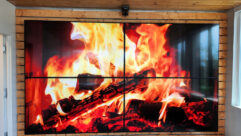
Setting the AV Stage, Part 2
Aug 9, 2011 12:18 PM,
with Bennett Liles
Listen to the Podcasts
|
Editor’s note: For your convenience, this transcription of the podcast includes timestamps. If you are listening to the podcast and reading its accompanying transcription, you can use the timestamps to jump to any part of the audio podcast by simply dragging the slider on the podcast to the time indicated in the transcription.
The AV staging industry is a dynamic business with new technology, new demands from clients and no second takes. Women are making their mark on the event staging world and Midori Connolly is back for Part 2 to tell us what she’s doing to help women get into the industry and advance—coming up right now on the SVC podcast.
Midori Connolly thanks for being back with me for Part 2 on the SVC podcast.
Thank you for having me.
And we’re talking about Pulse Staging and Events in San Diego and some of the challenges that staging companies like yours, in particular, have especially because of the fact that you’re very sustainability-conscious and you also work in a lot of new media, which a lot of the staging companies aren’t all that into yet, so you’re on the cutting edge in both of those. How do you handle hybrid gear events in that you may be using some of your gear but may have to interface it with a venues system or gear from somebody else? Are there particular ways that you work that out?
In most cases we would generally only be using our gear. Our engineers need things to be perfect when they step into that room…a lot of times what we will do in this case and generally it’s not necessarily using equipment that comes from the venue but it may come from one of our local partners so sometimes what we’ll do is actually fly in one of our lead engineers—maybe a day or a day or two early—and they’ll actually go and build…make sure that the system is built to what they want. We’ve worked in a couple of theaters that way. We had a project in New York recently where our engineer…he arrived two days early and made sure that he had it dialed to his specifications—he had it where he wanted it and it was really quite funny, because their in-house operators learned a of things that he was a expert on their boards so they actually enjoyed it. They found it to be really fun and educational for them so he…this is somebody who has 25 years experience and they had maybe five to 10 so it was fun for them. Sometimes we have situations where we’re brought in by our clients and it could be—I don’t want to say hostile but it’s viewed as we are taking business from maybe the in house provider or the existing teams that are there at the venues so in those cases we do our absolute best to sort of share the work. So I mentioned in Part 1 that we look for local labor wherever we can so knowing that generally AV companies really just want to keep their people working, they want to keep their gear working and with us having mostly a perma-lancer model for our key engineers and technicians we will try to work with the venues so that we can keep their people working maybe in some general labor roles or we can manage the labor for them but in most cases we’re so finicky about our gear that it’s usually either we’re using our equipment or working with a local partner and making sure that we have it set up exactly how we need it to be. [Timestamp: 3:44]
And one of the things that you see particularly on corporate events is a lot of live IMAG and that can either be just deadly dull or very challenging for a camera operator if you have a very animated and say, long-winded presenter and it’s either done very well or it’s conspicuous in how bad it looks. So do you go local for IMAG people or just trust your network?
Yeah and again, that’s one of those ones —I hate to use it but it depends—in some cases for some of our clients the IMAG requirements are really simple. I mean, it may just be one camera, just point it at the lectern for eight hours a day and we’re not working with high def, but in the other instances usually what we do…so if we go into a local market and we don’t have anybody, specifically we don’t have one of our go-to people, we will ask those go-to people or if they’re not available we’ll ask them for references. We also work…so for example in Chicago where we have to work in many cases with local union labor, we work with labor brokers so they can make great suggestions for us. They know their market very well and so labor brokers can be a great way to find some of the best talent in the area. [Timestamp: 5:09]
And I would think that sometimes when you have a tightly scripted format where you’ve got a script to follow and you’re synchronizing technical operations with that there could be somebody coming along say without the full appreciation on what it takes to get this whole tech freight train rolling and they might be making changes at the last minute, and with your experience level I would think that you’ve had such things happen.
Yeah and again I think this really comes down to the people management. In most cases equipment is equipment is equipment. It’s just gear and it’s technology and it may do fantastic things but unless you have good people to make that technology do something wonderful it’s just technology for technology’s sake. So for us this is where making sure we have the best people in lead positions and when we’re working for producers which I had mentioned before we work frequently for creative producers, production houses and in many cases they will actually be taking the lead on making sure that we have the correct rehearsal times but when that’s not possible it’s…that’s when it’s just imperative to have good project managers—I should say great project managers—technical directors making sure that those lead people are not only good with the technology but are very, very good at managing people and time so there’s a lot more to just coming and being able to throw a switch or point a camera. The lead people are very key. [Timestamp: 6:48]
Right—knowing where…when to use the honey and when to break out the whip and the chair.
Exactly, exactly. Absolutely.
So I know that you’ve been recognized widely in businesswomen’s organizations. Tell me a little bit about your activity in those.
Being a woman business owner in the audio visual industry has been…it’s been really interesting and I’ve actually earned this nickname “Chief AV Girl” because many times, as we all know, it’s obviously very male-dominated and I think what happens a lot of the times, male or female, when we work in an industry and we’re very familiar with the technology and it’s the world we live in, we forget to speak the language of those who don’t live in that world, so I think for me being able to step into the industry with an outsider’s view was where that “AV Girl” thing came in, where I love the technology, understand it, I get it, it’s great, but you know what, half the time I can’t remember what that acronym meant or what this meant so I’m able to explain things—I ask every dumb question in the world on behalf of clients or people who want to know about AV and then I speak to them in very plain terms. And so I hate to make it a male/female things because I know plenty of our female technicians who speak just as confusing as the men but I think that I have tried to focus on helping younger women to make their way through the industry. They may have a love of technology but it can be very difficult when you are sort of the minority in industry to be taken seriously so I think for me, I’ve just tried to look for some of the more talented standouts and just make sure that we re-hire them when we go into, as I mentioned, the union markets. I’m asking for general laborer—I will ask specifically for a certain percentage of female laborers because I feel that it is important to do that so…and I guess in that way I have supported women in business and that I think may be where some of the recognition from organizations such as NAWBO which is the National Association of Women Business Owners, the San Diego Business Journal selected me as one of their Women Who Mean Business, so I tend to forget that though because it’s just such a course of doing business and sort of ties into the sustainability thing—just making sure that we’re taking care of people just as much as we do business and the planet so sometimes I shy away from that because I forget, I guess, about it. [Timestamp: 9:32]
Setting the AV Stage, Part 2
Aug 9, 2011 12:18 PM,
with Bennett Liles
Well I guess the best thing is just to concentrate on doing your job right and let the accolades fall where they may.
Right and I’m very appreciative too. I don’t want to…I want to make sure that is clear. It’s a lot of gratitude. [Timestamp: 9:45]
And so we’ve got management and then we’ve got technical jobs—the nuts-and-bolts people. So in which of these AV areas do you see that women are playing the most prominent roles?
I think that probably traditionally they’ve been placed in more of the communications roles—maybe some of the more creative positions but honestly more and more I’m…I really…even just in the last…gosh, I think even just the last year, and I don’t know if it’s because of the economy or a shift in labor markets, but now when I go out on jobs it seems like I am seeing two maybe three technicians who are female who are either general laborer, set strike and it’s been fun for me to see this transition. I know on LinkedIn there’s a group of women in AV that’s just been started and is picking up traction constantly so maybe it’s the conversation that needed to be started ,but I have heard some horror stories of women in the industry—veteran professionals who have been told, “Oh sweetie you’ll never do that.” or “Oh that’s not for women, you should be in the office.” So maybe it’s changing which is very encouraging I think. [Timestamp: 11:01]
Well I was going to ask as far as staging and AV company, how do you attract women into the tech side of the business? Do you find if they’re interesting in that or do they have to be sort of persuaded that that may be the way to go?
Yeah and I think that this stems from just maybe…bigger issues. There have been many studies done that have shown obviously the aversion of females to math and science because they were generally told that math and science is for boys and I know Microsoft has done quite a bit of work encouraging young women. There are some…I have…I know of at least four organizations that are for young women in technology so my part and what I try to do is to go out and educate and that’s part of that “AV girl” message of its…this technology is for everybody. You don’t have to be a science whiz to get this. If you like technology—if there’s something about it that appeals to you, there’s no reason not to pursue it and so my message is really about, “Don’t be intimidated—don’t be afraid,” and it’s OK to go out and ask the questions even if you look dumb because I do it all the time so it works and if this is something that a young woman was interested in and wanted to pursue there’s no reason not to do it. So for me it’s really about going out and spreading that message, educating young women—my ultimate goal is to set up scholarships for…maybe through Infocom, I’m really not for sure yet how to do that, but I would love to set up scholarships for young women who wanted to pursue this career path and so at least enabling them that way. [Timestamp: 12:47]
So were there any specific tech jobs in your experience which is considerable…where you find that women just tend to naturally excel or be better at it?
Well I think we can be grateful to the theater industry for pulling in more women onto the tech side and I don’t know…honestly I don’t think there is any one area. I think that in my experience it’s just wherever their passion lies whether it be lighting or sound. Truly you’re starting to see some diversity—I know some incredible video engineers who are women so it’s really across the board I would just say. Maybe it’s…they do say I guess women tend to be better communicators so maybe that’s where the fit is. I’m not really sure. [Timestamp: 13:32]
Well, I would think that one factor may be that they tend to learn faster because maybe they don’t have quite the ego thing in there where they would be afraid to ask what they think might be dumb questions.
Yeah I’ve heard that before and so maybe that’s where all of my dumb questioning is coming from. [Timestamp: 13:49]
Well Midori, it’s certainly has been great having you here. This has been a real treat. I’m sorry we didn’t connect at Infocomm, but I’m sure we’ll get you back for the podcast very soon—Midori Connolly from Pulse Staging and Events in San Diego.
Absolutely, thank you so much for having me. This actually was really fun even though I was very nervous so thank you everyone for listening.









